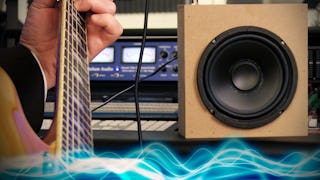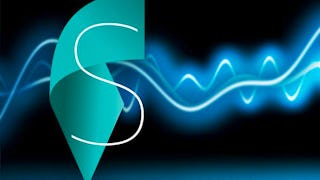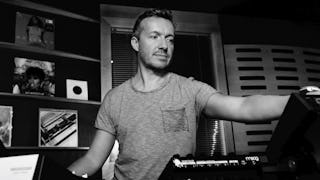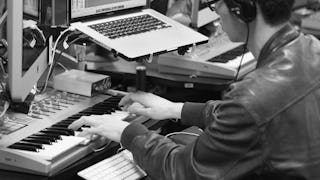In diesem Kurs lernen Sie Methoden der Audiosignalverarbeitung kennen, die spezifisch für Musik sind und in realen Anwendungen zum Einsatz kommen. Wir konzentrieren uns auf die spektralen Verarbeitungstechniken, die für die Beschreibung und Transformation von Klängen von Bedeutung sind, und entwickeln das grundlegende theoretische und praktische Wissen, mit dem Sie Audiosignale im Kontext von Musikanwendungen analysieren, synthetisieren, transformieren und beschreiben können. Der Kurs basiert auf offener Software und offenen Inhalten. Die Demonstrationen und Programmierübungen werden mit Python unter Ubuntu durchgeführt, und die Referenzen und Materialien für den Kurs stammen aus offenen Online-Repositories. Die für den Kurs entwickelte Software und die Materialien werden ebenfalls mit offenen Lizenzen vertrieben.



(292 Bewertungen)
Kompetenzen, die Sie erwerben
- Kategorie: Computerprogrammierung
- Kategorie: Mathematische Theorie & Analyse
- Kategorie: Mathematik
- Kategorie: Python-Programmierung
- Kategorie: Algorithmen
Wichtige Details
10 Aufgaben
Erfahren Sie, wie Mitarbeiter führender Unternehmen gefragte Kompetenzen erwerben.

In diesem Kurs gibt es 11 Module
Einführung in den Kurs, in das Gebiet der Audiosignalverarbeitung und in die mathematischen Grundlagen, die für den Beginn des Kurses erforderlich sind. Einführende Demonstrationen zu einigen der zu verwendenden Softwareanwendungen und Tools. Einführung in Python und in das Paket sms-tools, das wichtigste Programmierwerkzeug für den Kurs.
Das ist alles enthalten
11 Videos1 Lektüre1 Aufgabe1 Programmieraufgabe
Die Gleichung der Diskreten Fourier-Transformation; komplexe Exponentiale; Skalarprodukt in der DFT; DFT komplexer Sinusschwingungen; DFT reeller Sinusschwingungen; und inverse DFT. Demonstrationen zur Analyse eines Tons mit Hilfe der DFT; Einführung in Freesound.org. Generierung von Sinuskurven und Implementierung der DFT in Python.
Das ist alles enthalten
6 Videos1 Lektüre1 Aufgabe1 Programmieraufgabe
Linearität, Verschiebung, Symmetrie, Faltung; Energieerhaltung und Dezibel; Phasenentfaltung; Zero Padding; Fast Fourier Transformation und Nullphasenfensterung; und Analyse/Synthese. Demonstration der Analyse einfacher periodischer Signale und komplexer Klänge; Demonstration von Tools zur Spektrumanalyse. Implementierung der Berechnung des Spektrums eines Klangfragments mit Python und Vorstellung der im Paket sms-tools implementierten dftModel-Funktionen.
Das ist alles enthalten
7 Videos1 Lektüre1 Aufgabe1 Programmieraufgabe
STFT-Gleichung; Analysefenster; FFT-Größe und Hop-Größe; Zeit-Frequenz-Kompromiss; inverse STFT. Demonstration von Tools zur Berechnung des Spektrogramms eines Tons und wie man einen Ton damit analysiert. Implementierung der Fensterung von Tönen mit Python und Vorstellung der STFT-Funktionen aus dem Paket sms-tools mit Erläuterungen zu ihrer Verwendung.
Das ist alles enthalten
6 Videos1 Lektüre1 Aufgabe1 Programmieraufgabe
Gleichung des Sinusmodells; Sinuswellen in einem Spektrum; Sinuswellen als spektrale Spitzen; zeitlich veränderliche Sinuswellen im Spektrogramm; Sinussynthese. Demonstration der Sinusmodell-Schnittstelle des Pakets sms-tools und ihrer Verwendung bei der Analyse und Synthese von Klängen. Implementierung der Erkennung von Spektralspitzen und der Sinussynthese mit Python und Vorstellung der sineModel-Funktionen aus dem sms-tools-Paket mit Erläuterungen zu ihrer Verwendung.
Das ist alles enthalten
8 Videos1 Lektüre1 Aufgabe1 Programmieraufgabe
Harmonische Modellgleichung; Sinusoide-Teiltöne-Harmonische; polyphone-monophone Signale; Erkennung von Harmonischen; f0-Erkennung im Zeit- und Frequenzbereich. Demonstration des Algorithmus zur Erkennung von Tonhöhen, der Oberfläche des harmonischen Modells des Pakets sms-tools und seiner Verwendung bei der Analyse und Synthese von Klängen. Implementierung der Erkennung der Grundfrequenz im Frequenzbereich unter Verwendung des TWM-Algorithmus in Python und Vorstellung der harmonicModel-Funktionen aus dem sms-tools-Paket mit Erläuterungen zu ihrer Verwendung.
Das ist alles enthalten
7 Videos1 Lektüre1 Aufgabe1 Programmieraufgabe
Stochastische Signale; stochastisches Modell; stochastische Annäherung von Klängen; Sinus-/Harmonik-plus-Residuum-Modell; Subtraktion von Residuen; Sinus-/Harmonik-plus-stochastisches Modell; stochastisches Modell von Residuen. Demonstration des stochastischen Modells, des harmonischen plus Residualmodells und der harmonischen plus stochastischen Schnittstellen des Pakets sms-tools und seiner Verwendung bei der Analyse und Synthese von Klängen. Vorstellung der Funktionen stochasticModel, hprModel und hpsModel, die im Paket sms-tools implementiert sind, und Erläuterung ihrer Verwendung.
Das ist alles enthalten
8 Videos1 Lektüre1 Aufgabe1 peer review
Filterung und Morphing unter Verwendung der Kurzzeit-Fourier-Transformation; Frequenz- und Zeitskalierung unter Verwendung des Sinusmodells; Frequenztransformationen unter Verwendung des harmonischen plus Residualmodells; Zeitskalierung und Morphing unter Verwendung des harmonischen plus stochastischen Modells. Demonstrationen der verschiedenen Transformationsschnittstellen des sms-tools-Pakets und von Audacity. Vorstellung der Funktionen stftTransformations, sineTransformations und hpsTransformations, die im Paket sms-tools implementiert sind, und Erläuterung ihrer Verwendung.
Das ist alles enthalten
9 Videos1 Lektüre1 Aufgabe1 peer review
Extraktion von Audiomerkmalen mit Methoden der Spektralanalyse; Beschreibung von Klängen, Klangsammlungen, Musikaufnahmen und Musiksammlungen. Clustering und Klassifizierung von Klängen. Demonstration verschiedener Plugins von SonicVisualiser zur Beschreibung von Klang- und Musiksignalen und Demonstration einiger fortschrittlicher Funktionen von freesound.org. Vorstellung von Essentia, einer C++-Bibliothek für die Beschreibung von Klängen und Musik, und Erläuterung, wie sie von Python aus verwendet werden kann. Programmierung mit der Freesound API in Python, um Klangsammlungen herunterzuladen und zu untersuchen.
Das ist alles enthalten
6 Videos1 Aufgabe1 peer review
Audiosignalverarbeitung über diesen Kurs hinaus. Über die Audiosignalverarbeitung hinaus. Rückblick auf die Kursthemen. Wo Sie mehr über die Themen dieses Kurses erfahren können. Vorstellung von MTG-UPF. Demonstration von Dunya, einem Webbrowser zur Erkundung verschiedener Audiomusiksammlungen, und von AcousticBrainz, einer kollaborativen Initiative zur Sammlung und gemeinsamen Nutzung von Musikdaten.
Das ist alles enthalten
6 Videos1 Lektüre1 Aufgabe
Das ist alles enthalten
3 peer reviews
Dozenten


Mehr von Softwareentwicklung entdecken


University of Rochester


École Polytechnique Fédérale de Lausanne
Warum entscheiden sich Menschen für Coursera für ihre Karriere?




Bewertungen von Lernenden
292 Bewertungen
- 5 stars
87,67 %
- 4 stars
8,90 %
- 3 stars
1,71 %
- 2 stars
0,68 %
- 1 star
1,02 %
Zeigt 3 von 292 an
Geprüft am 26. Mai 2021
Very complete and awesome course. Perfect for intermediate level dsp knowledge and concepts reinforcements
Geprüft am 4. Juni 2017
Excellent course, for me this was pitched at just the right level to be interesting and also challenging. Everything was well explained and well structured.
Geprüft am 3. Dez. 2016
Top class! Very well explained, good examples, excellent learning material, practical exercises, and lots and lots of room for further personal study! Well done guys, and especially Xavier! Cheers!

Neue Karrieremöglichkeiten mit Coursera Plus
Unbegrenzter Zugang zu 10,000+ Weltklasse-Kursen, praktischen Projekten und berufsqualifizierenden Zertifikatsprogrammen - alles in Ihrem Abonnement enthalten
Bringen Sie Ihre Karriere mit einem Online-Abschluss voran.
Erwerben Sie einen Abschluss von erstklassigen Universitäten – 100 % online
Schließen Sie sich mehr als 3.400 Unternehmen in aller Welt an, die sich für Coursera for Business entschieden haben.
Schulen Sie Ihre Mitarbeiter*innen, um sich in der digitalen Wirtschaft zu behaupten.
Häufig gestellte Fragen
Ja, dieser Kurs ist kostenlos. Sie können den Kurs besuchen, die Aufgaben erledigen und eine Abschlussnote erhalten - völlig kostenlos.
Nein, diese Option bieten wir nicht an.
Alle Materialien und Tools für den Kurs sind online unter offenen Lizenzen verfügbar.






